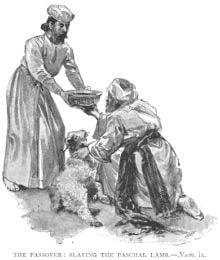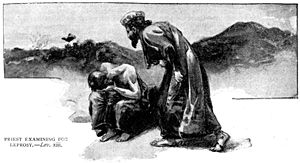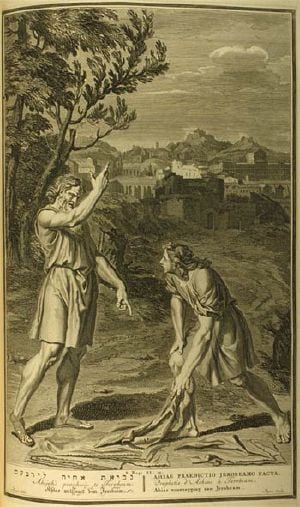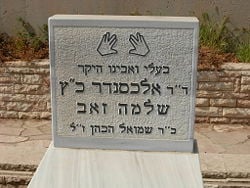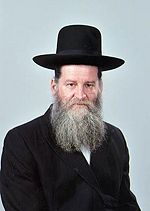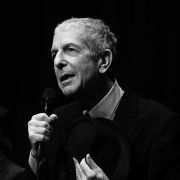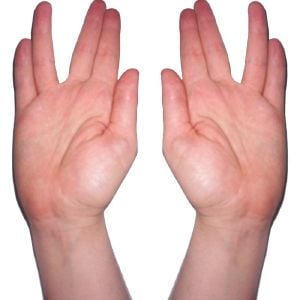Kohen (Cohen)
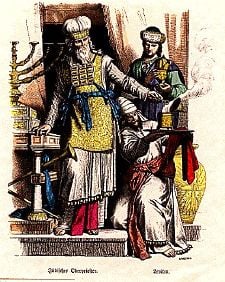
A kohen (or cohen, Hebrew: כּהן, "priest;" pl: kohanim) is a Jewish priest, a direct male descendant of the Biblical Aaron, brother of Moses. Kohanim are distinct from but related to Levites, who also served in a priestly capacity, or as the assistants to the kohanim.
During the existence of the Temple in Jerusalem, kohanim performed specific duties vis-à-vis the daily and festival sacrificial offerings. The kohen gadol (high priest) sometimes held considerable political influence and also supervised during the key service of Yom Kippur.
Although they faced competition from non-Aaronic priests at the local high places and were sometimes criticized by the prophets for corruption, the kohanim played a central role in the religious life of ancient Judah. Their leadership became more accepted after the establishment of the Second Temple following the Babylonian exile. It was also the kohanim and their scribes who wrote much of the Hebrew Bible.
After the destruction of the Temple in 70 C.E., the kohanim have lost their formerly crucial function of offering sacrifices and have been replaced as Judaism's key religious leaders by the rabbis. However, they retain an honored status within some branches of Judaism. They offer special priestly blessings and are bound by certain laws in Orthodox and some Conservative Jewish communities. The name "Cohen" and derivative surnames does not always indicate that a person is actually a kohen.
Biblical origins and history
The status of kohen was first conferred on Moses' brother Aaron and his direct male descendants (Exodus 28:1-4) as an "everlasting office." During the 40 years in which the Jews wandered in the wilderness and until the Temple in Jerusalem was built, the kohanim performed their service in the portable Tabernacle (Numeri 1:47-54). Their duties involved offering the daily and Jewish holiday sacrifices and blessing the people in a ceremony known as Nesiat Kapayim ("raising of the hands"), the ceremony of the blessing.
The kohanim assumed these same roles in the Jerusalem Temple once it was established. They were divided into 24 work groups of seven to nine priests each. The groups rotated every Sabbath, but on the major biblical festivals all 24 were present in the Temple as pilgrims came from throughout the country to offer sacrifices.
Since Aaron was a member of the Tribe of Levi, all kohanim are Levites, but not all Levites are kohanim. The Levites, as distinct from the kohanim, provided a variety of other Temple roles, most notably providing music and psalms, acting as scribes, washing the priests' hands and feet before services, standing guard over the Temple Mount, construction, and maintenance. During the era of the Tabernacle, the Levites were also employed in caring for and transporting the Tabernacle between travel destinations.
Priests also served as key advisers to the kings of Judah. In some cases they were faithful, but at other times they fell victim to temptation, as was the case with the high priest Abiathar, who supported the usurper Adonijah to succeed King David. He was later deposed, and the high priesthood fell to Zadok and his sons.
In the northern kingdom of Israel, the kohanim played no role, leading them to denounce Israel as apostate. In the southern kingdom of Judah the kohanim of Jerusalem competed with the non-Aaronic priests and Levites who offered sacrifices outside of Jersualem at the local high places, which were considered unauthorized shrines by the kohanim. Several kings of Judah made attempts to centralize worship in Jerusalem, and during the reign of Hezekiah and again during that of Josiah, many of the high places were closed or destroyed.
The kohanim sometimes came under criticism by the prophets for avarice and corruption. Thus, the prophet Isaiah declared, in a passage echoed by many of his fellow prophets:
I have more than enough of burnt offerings, of rams and the fat of fattened animals; I have no pleasure in the blood of bulls and lambs and goats… Learn to do right! Seek justice, encourage the oppressed. Defend the cause of the fatherless, plead the case of the widow (Isaiah 1:11-17).
Even though the majority of the kohanim may have been sincere and morally upright, there was no guarantee that they would be correct in their political judgments. During the time of Jeremiah, for example, several key kohanim wrongly advised the Judean kings to resist the power of Babylon, against Jeremiah's warnings. Earlier, the high priest Abiathar had backed the usurper Adonijah to replace King David and was himself replace by his fellow kohan Zadok.
On the other hand, the kohanim also served a crucial function in enabling the people of Judah and Israel to fulfill their religious duties as prescribed in the Torah. They also had the authority to decide certain cases of law. According to the prophet Ezekiel, "The priests are to serve as judges and decide according to my ordinances" (Ezekiel 44:24). It was also the kohanim and their Levite scribes who compiled much of the sacred scriptures that later came to constitute the Hebrew Bible.
After the rebuilding of the Temple at the end of the Babylonian exile, the kohanim played an increasingly important role in the religious life of the Jewish people until the rise of rabbinic Judaism. Thereafter, the rabbis came to occupy the central religious roles, especially after the destruction of the Second Temple.
Qualifications
In biblical times, kohanim could assume their duties once they reached physical maturity, usually associated with the age of 13. However, in later years kohanim normally begin serving at the age of 20 (Talmud Bavli:Hullin 24b, and Mishneh Torah:Hilchoth Klei HaMiqdash 5:15). There was no mandatory retirement age. Only when a kohen became physically infirm could he no longer serve.
Certain physical imperfections could disqualify a kohen from serving in the Temple. These blemishes include:
- Blindness
- Lameness
- An excessively low nasal bridge
- Disproportionate limbs
- A crippled foot or hand
- Eyebrows that grow profusely
- Cataracts
- A white streak that transverses the white part of the eyeball and iris
- Certain types of boils
- Leprosy and other skin diseases
- Crushed testicles or castration
This, however, is not a comprehensive list (see Leviticus 21:18-20). A kohen who was afflicted with one of these imperfections was held unfit for service. However, should it be a correctable imperfection, the kohen would become eligible for service should the defect be corrected. In addition, kohanim with these blemishes could be assigned to secondary roles in the Temple outside of performing the service itself.
Because they were excluded from the tribal allotments and therefore did not normally own large parcels of land, the kohanim were rewarded with 24 special "priestly gifts." These included portions of various offerings of animal, grain, oil, bread, the firstborn of any domestic kosher animal, the "first fruits," and the organs and skins of certain offerings.
Women were never allowed to serve in the Tabernacle or the Temple. Female relatives of kohanim, however, were permitted to consume or use some of the priestly gifts. If a kohen's daughter married a man from outside the kohanic line, she was no longer permitted to consume the priestly gifts. Conversely, the daughter of a non-priest who married a kohen took on the same rights as an unmarried daughter of a kohen.
The High Priest
In every generation when the Temple was standing, one kohen would be appointed to perform the functions of kohen gadol (high priest). His main job was the Yom Kippur service. However, he also offered a daily meal sacrifice, and he had the prerogative to supersede any kohen and offer any offering he chose. A kohen gadol could only marry a virgin and was expected to be careful to retain his own moral and ritual purity. The office normally passed from father to son, most famously in the long priestly lineage of Zadok. However, in the later Second Temple period various high priests were appointed by both Jewish and non-Jewish political governors, becoming an issue of considerable controversy. Also in this period, the high priest sometimes served as the president of the ruling legislative council, the Sanhedrin.
Ritual defilement
The kohanim formed a holy order. For the purpose of protecting them against ritual defilement, the Torah imposed on the following rules for ritual purity, which are still maintained in Orthodox Judaism.
- Kohanim are forbidden to come in contact with dead bodies, nor are they permitted to perform the customary mourning rites. They are commanded, however, to become "defiled" for their closest relatives: father, mother, brother, unmarried sister, child, or wife.
- A kohen is forbidden to touch anyone or anything that has been made ritually unclean through contact with the dead.
- A male kohen may not marry a divorcee, a prostitute, a convert to Judaism, or a dishonored woman. Any kohen who enters into such a marriage loses his priestly status while in that marriage.
- Any children born of a union not permitted to a kohen are legitimate. However, these children and their offspring lose the status of kohanim.
- During the period of the Holy Temple, kohanim were required to abstain from wine and all strong drink while performing their priestly duties.
The Talmud prescribes that if any kohen—even the Kohen Gadol—finds a corpse by the wayside, and there is no one else in the area who can be called upon to bury it, then the kohen himself must perform the burial (meis mitzvah). The Talmud also orders the kohen to defile himself in the case of the death of a nasi (rabbinic leader of a religious academy).
Current attitudes
While all branches of Judaism which accept Jewish law as binding recognize these rules in principle, they differ considerably in their practical application.
- Haredi Judaism tends to interpret the rules strictly, and tends to resolve doubts in favor of preserving the purity of the priesthood. Haredi rabbis will often refuse to perform a prohibited marriage. The Israeli Rabbinate will also not perform such a marriage and hence a kohen cannot legally marry a divorced or converted women (and so on) in the State of Israel, although a foreign marriage would be recognized.
- Modern Orthodox Judaism recognizes the rules as being in full force, but often practices leniency with respect to some of the rules' strictures. Modern Orthodox Jewish rabbis will often perform a prohibited marriage, but will not recognize the husband or their offspring as qualified kohanim.
- Conservative Judaism has issued an emergency takanah (rabbinical edict) temporarily suspending the application of the rules in their entirety, on the grounds that the high intermarriage rate in its community threatens the survival of Judaism, and hence that any marriage between Jews is welcomed. The ruling declares that the offspring of Jewish marriages normally forbidden to kohanim are to be regarded as kohanim in good standing.
- Reform Judaism, Reconstructionist Judaism, and Secular Judaism generally do not recognize a special status for kohanim, considering the priestly office obsolete, as well as anti-egalitarian and/or sexist.
Critical view
Critical scholars point out that the traditional view of the kohanic history is based on the view developed by Judaism in the Second Temple period and beyond, which emphasizes the central role of Jerusalem and its priesthood and may thus contain a prejudicial attitude toward non-Aaronid and non-Levitical priests.
A critical analysis of the biblical records leads to the possible conclusion that in the early days of Israelite settlement, various priestly lineages were in evidence at several different locations, in addition to the supposedly central Tabernacle at Shiloh. When the sacred Ark of the Covenant was moved to Jerusalem, however, a centralizing myth began to take form, culminating in the idea of the Aaronid priests as the sole authority to offer sacrifice and Jerusalem as the only authorized sanctuary. The support of the northern king Jeroboam by the prophet Ahijah of Shiloh may represent in part a rebellion of the northern priesthood against the dominance of Jerusalem. Meanwhile, the constant opposition of the Books of Kings and other works of the Deuteronomic history to the priests of the high places, especially the shrines of Dan and Bethel, is additional evidence that the exclusivity of the kohanic priesthood was not universally accepted.
Another area in which the traditional view is criticized is on the question of the rights of the Levites. Evidence that all members of the tribe of Levi, not just the descendants of Aaron, were entitled to priesthood is furnished in the provision of the Deuteronomic code for those Levites who were scattered through the country as priests of the local sanctuaries. When these Levites were left without any means of support as a result of the Deuteronomic refroms—probably issued during the time of King Josiah—those Levites who desired to enter the ranks of the priesthood of Jerusalem were admitted to equal privileges kohanim who ministered there (Deut. 18:6-8). As a matter of fact, however, the priests of Jerusalem did not allow them to minister at the altar (2 Kings 23:8-9). According to this theory, the Deuteronomic reformation thus marks the first step toward the new development in the priesthood in exilic and post-exilic times.
The attitude of the priests of Jerusalem toward those of the local sanctuaries was sanctioned by Ezekiel during the time of the Babylonian Exile. In his book, the priesthood of Jerusalem is called "the house of Zadok," after Zadok, who had replaced Abiathar. Ezekiel declared that of all the Levite priests, only the Zadokites should be admitted to the service of the altar. The rest, who had defiled themselves by officiating at the local sanctuaries, should be degraded to the position of mere servants in the sanctuary, replacing the foreign Temple attendants who had heretofore performed all menial services (Ezek. 40:46, 43:19, 44:6-16). According to this view, Ezekiel's new regulations formed the basis of the post-exilic priestly system which is formulated in detail in the Priestly Code.
The kohen's role today
Today, the status of kohen is assumed by any male Jew who has a demonstrable family tradition to that effect. Until the eighteenth century in Europe, (nineteenth century in Yemen) many kohanim claimed to be able to trace their lineages back to a verifiable kohen such as Ezra. Today, families may verify their priestly lineage via the tombstones of deceased ancestors. In such cases, the symbol of the hands arranged for the priestly blessing, a time-honored engraving for the tombstones of kohanim, is acceptable evidence of kohanic status. Simply having the family name of "Cohen" (Cohn, Kogan, Kagan, Kohen, and so on), is not proof enough, as assimilation and intermarriage have conferred the name on many non-priestly individuals.
In Orthodox Judaism and to some extent in Conservative Judaism, Kohanim maintain their special status in the following areas of modern life:
Every Monday, Thursday and Shabbat in Orthodox synagogues (and many Conservative ones as well), a portion from the Torah is read aloud in the original Hebrew in front of the congregation. On weekdays, this reading (aliyah) is divided into three; it is customary to call a kohen for the first reading, a Levite for the second reading, and a member of any other tribe of Israel to the third reading. On Shabbat, the reading is divided into seven portions; a kohen is called for the first aliyah and a levite to the second.
It is considered beneath the kohen's dignity to call him up for any of the other aliyot. In Orthodox Jewish circles, this custom has the status of law. The Conservative Rabbinical Assembly's Committee on Jewish Law and Standards (CJLS) has ruled that the practice of calling a kohen to the first aliyah represents a custom rather than a law, and that accordingly, a Conservative rabbi is not obligated to follow it. As such, in some Conservative synagogues, this practice is not followed.
All of the kohanim participating in an Orthodox prayer service must also deliver the priestly blessing, called nesiat kapayim, during the repetition of the Shemoneh Esrei, the central prayer of the Jewish liturgy. The text of this blessing is found in Numbers 6:23-27:
- Tell Aaron and his sons, This is how you are to bless the Israelites. Say to them:
- "The Lord bless you and keep you;
- the Lord make his face shine upon you and be gracious to you;
- the Lord turn his face toward you and give you peace."
- So they will put my name on the Israelites, and I will bless them.
The kohanim perform this rite by standing in the front of the synagogue and facing the congregation, with their arms held outwards and their hands and fingers in a specific formation. Part of this blessing (vss. 25-26) has been inherited in Christian tradition as well, in which a minister often delivers the blessing as a closing benediction before dismissing the congregation.
Some, but not all, Conservative congregations allow the daughter of a kohen (bat kohen) to offer the priestly blessing. The majority of Reform Jews and Reconstructionist Jews consider all rules and ceremonies regarding the priesthood to be outdated. Many consider it to be anti-egalitarian, and thus discriminatory against Jews who are not kohanim, as well as sexist by forbidding females to act as priests. Therefore the honors given to the kohan during the Torah reading and in the performance of the priestly are not observed in Reform or Reconstructionist Jewish communities.
Outside the synagogue, kohanim serve the distinction of leading the Pidyon Haben, the symbolic Redemption of the First-born ceremony for first-born male sons. This tradition is based on the Torah commandment, "and you shall redeem all the firstborn of man among your sons."
In Orthodox and Conservative circles, this ceremony is conducted as part of a festive meal. The kohen first washes his hands and breaks bread, then calls for the father and the baby. The baby is typically brought in dressed in white and bedecked with gold jewelry. The kohen then engages the father in a formal dialog, asking him whether he prefers to keep his money or his son. At the end of this exchange, the father hands over five silver coins, and the kohen blesses him and his son. The child of a kohen is exempt from the requirement of redemption.
According to the Conservative Jewish view, some rabbinic sources allow women to perform this ritual, and thus a bat kohen may perform the ceremony for a newborn son. Reform and Reconstructionist Jews generally do not perform this ceremony.
The kohen gene
Recently the tradition that kohanim are descended from a common ancestor was supported by genetic testing.[1] Since all direct male lineage shares a common Y chromosome, testing was done across sectors of the Jewish population to see if there was any commonality between their Y chromosomes. There was proven to be certain distinctions among the Y chromosomes of kohanim, implying that many kohanim do share some common ancestry, though not necessarily Aaronic. The information was also used to support the claim of the Lemba (a sub-Saharan tribe) that they were in fact, a tribe of Jews. Genetic tests also confirmed the claim of the Samaritan priesthood, long rejected by traditional Judaism, to be of ancient Israelite descent.
Cohen as a surname
Although the name "Cohen" and similar surnames derive from the word kohen in the sense of a Jewish priest and many kohanim do have this family name, there are also many families with the surname Cohen who are not kohanim. Conversely, there are many kohanim who do not have Cohen as a surname. There are numerous variations to the spelling of the surname Cohen. These are often exemplified below (not a complete list).
- English: Cohen, Cahn, Conn, Conway, Cohan, Chaplan (Cohan is also an Irish surname and Conway is also a surname of Welsh origin)
- German: Kohn, Kuhn, Kahn, Cön/Coen, Katz (name) (a Hebrew abbreviation for Kohen Zedek (כהן צדק) that is, "righteous Kohen" or "righteous priest")
- Dutch: Cohen, Conklin, Kon, Katten (translated as "Kohen"), Käin/Kaein
- French: Cahen, Cohen, Caen
- Italian: Coen, Sacerdote, Sacerdoti (Italian for "priest")
- Spanish: Coen, Cohen, Koen, Cannoh, Canno, Canoh, Cano
- Russian: Kogan, Kagen, Kagedan
- Serbian: Koen, Kon, Kojen
- Polish: Kaplan (loanword into Polish for "priest")'
- Portuguese: Cunha
- Turkish: Kohen
- Arabic: al-Kohen
- Ancient/Modern Hebrew: Kohen, Hakohen, ben-Kohen, bar-Kohen
References in popular culture
The positioning of the kohen's hands during the priestly blessing was Leonard Nimoy's inspiration for Mr. Spock's Vulcan salute in the original Star Trek television series. Nimoy, raised an Orthodox Jew (but not a kohen), used the salute when intoning the blessing: "Live long and prosper."
In addition, Robin Williams' characterization as extra-terrestrial Mork (in the American sitcom Mork & Mindy) included a salutation with a position of his hands which was very similar to kohen's hands during the priestly blessing, (along with the words: "Na-Nu, Na-Nu").
Notes
- ↑ Skorecki et al., 1997.
ReferencesISBN links support NWE through referral fees
- Blenkinsopp, Joseph. Sage, Priest, Prophet: Religious and Intellectual Leadership in Ancient Israel. Library of ancient Israel. Louisville, Ky: Westminster John Knox Press, 1995. ISBN 978-0664252939.
- Himmelfarb, Martha. A Kingdom of Priests: Ancestry and Merit in Ancient Judaism. Jewish culture and contexts. Philadelphia: University of Pennsylvania Press, 2006. ISBN 978-0812239508.
- Skorecki, K., S. Selig, S. Blazer, R. Bradman, N. Bradman, P. J. Warburton, M. Ismajlowicz, and M. F. Hammer. 1997. "Y Chromosomes of Jewish Priests." Nature 6611: 32. OCLC 1586310
- Tiemeyer, Lena-Sofia. Priestly Rites and Prophetic Rage: Post-Exilic Prophetic Critique of the Priesthood. Forschungen zum Alten Testament, 19. Tübingen: Mohr Siebeck, 2006. ISBN 978-3161490590.
External links
All links retrieved March 3, 2025.
- The Jewish Priest, the Kohen and Kohanim - Chabad.org Knowledge Base
- Jewish priest's prohibitions in marriage - Chabad.org Parsha
Credits
New World Encyclopedia writers and editors rewrote and completed the Wikipedia article in accordance with New World Encyclopedia standards. This article abides by terms of the Creative Commons CC-by-sa 3.0 License (CC-by-sa), which may be used and disseminated with proper attribution. Credit is due under the terms of this license that can reference both the New World Encyclopedia contributors and the selfless volunteer contributors of the Wikimedia Foundation. To cite this article click here for a list of acceptable citing formats.The history of earlier contributions by wikipedians is accessible to researchers here:
The history of this article since it was imported to New World Encyclopedia:
Note: Some restrictions may apply to use of individual images which are separately licensed.
